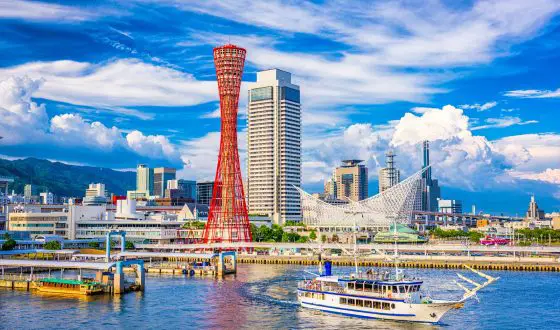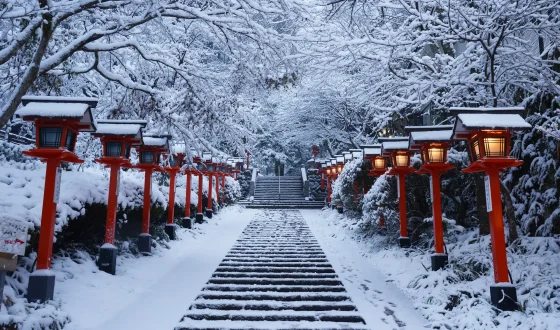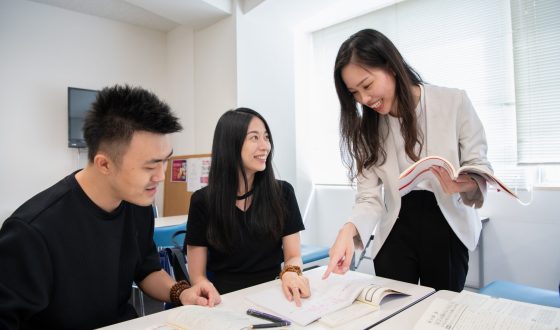Average Age of Death in Japan Keep Getting Higher – Here’s Why
It is probably not a new fact that Japan’s lifespan is among the highest. But do you know the average age of death in Japan used to be much lower in the past? What makes the Japanese make such rapid progress in extending longevity? The answers will be included in this article.
1. Average Age of Death in Japan in 2021
The average age of death or life expectancy measures the time from births to premature or mature death. The following global demographics show the latest life expectancy statistics from the United Nations. It seems there are large differences in health across the globe. The population of many countries with the worst health life expectancy lives up to 50 and 60 years old. The life expectancy Central African Republic is the lowest, at 53 years. On the other hand, citizens in the most developed countries such as America, England, Australia, and Japan live over 85 years on average.
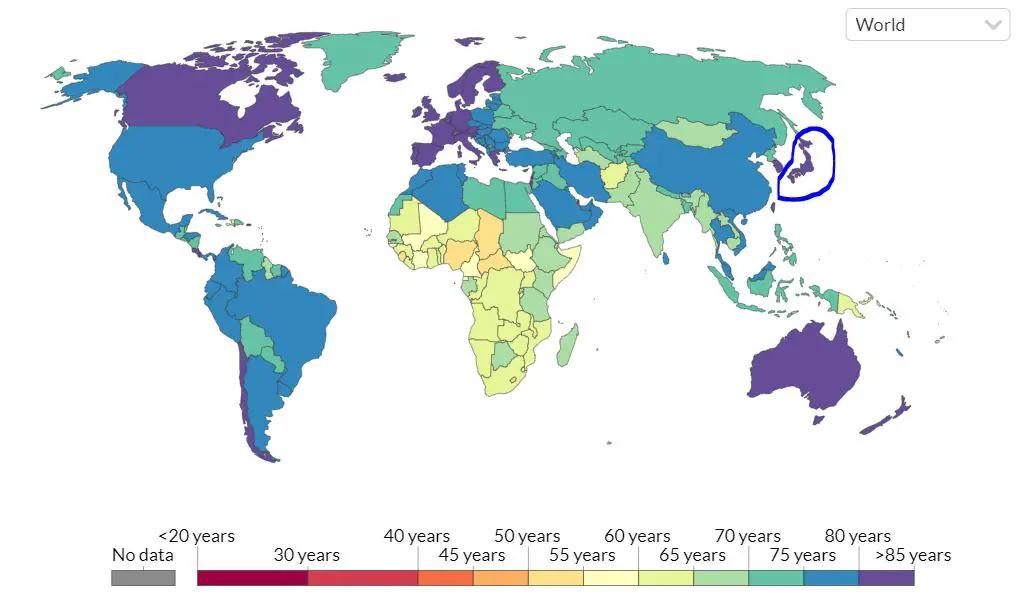
Japan is among the countries with the highest life expectancy.
SEE MORE:
- Planning A Trip To Japan Like A Travel Master
- The Rise Of Dark Tourism In Japan – Top 12 Scariest Destinations
According to a United Nations report in 2020, the Japanese have the second-highest average age of death (85.29 years old). The figure is just barely below that for Hong Kong (85.29 years old) and much higher than that for the world (73.2 years old). Like most other nations, Japan experiences the same trend that females normally live longer than males. To be specific, the average life expectancy for Japanese women is 88.1 while men expect to die around 6.2 years earlier, at 81.9 years old.
| Rank | Country | BOTH SEXES | FEMALES | MALES |
| 1 | Hongkong | 85.29 | 88.17 | 82.38 |
| 2 | Japan | 85.0 years
|
88.1 years
|
81.9 years
|
| 4 | Switzerland | 84.25 | 86.02 | 82.42 |
| 5 | Singapore | 84.07 | 86.15 | 82.06 |
| 8 | Australia | 83.94 | 85.80 | 82.08 |
| 11 | South Korea | 83.50 | 86.42 | 80.46 |
| 29 | United Kingdom | 81.77 | 83.28 | 80.22 |
| 46 | United States | 79.11 | 81.65 | 76.61 |
| 64 | China | 77.47 | 79.73 | 75.36 |
| The World | 73.2 years
|
75.6 years
|
70.8 years
|
Sources: United Nations
Note: the above data don’t include any effect of the coronavirus epidemic
2. The Growth in Average Age of Death in Japan
What may be surprising is that prior to the 1990s, Japanese life expectancy was too low to earn it a ranking in the list of top 100 countries. Statistics from OECD also show that in the early 1960s, the average age of death in Japan used to be the lowest among the G7 countries. On the contrary, the mortality was considerably high due to cerebrovascular disease and stomach cancer. Japanese life expectancy has undergone constant growth throughout the next decades. In 2016, Japan has already ranked first in terms of high life expectancy of all G7 countries (87.1 and 81.1 years old respectively for women and men). According to Nippon, the average age of death in Japan for both women and men keeps increasing over the recent years, reaching 87.45 and 81.4 in 2019. As we mentioned above, the figures for 2021 are even higher.

This partly reflects the increasing life expectancy around the world. The following map depicts the change in life expectancy in different demographic areas in the world over 65 years from 1950 to 2005. After half a century of progress in medical knowledge, we can expect to live much longer than our ancestors.

Globally the life expectancy rose from less than 60, 70 years to over 75 years. But few countries have such a dramatic increase in life expectancy as Japan. Such transformation is based on the falling infant and child mortality rate from 45 and 72 per 1,000 births to 1.6 and 2.2 per 1,000 births throughout the given period. Aside from child care, life expectancy in Japan actually goes up at all ages and the reason will be revealed in the latter part of the article.
3. Causes of death In Japan
The leading causes of death in Japan are old age-related, such as Alzheimer’s, Stroke, or Ischemic heart disease. But over a decade from 2009 to 2019, curable cerebrovascular diseases including stroke and ischemic heart disease have decreased considerably thanks to health development.

Source: The Global Burden of Diseases, Injuries, and Risk Factors Study (GBD)
Despite the efforts of the medical department in early detection and treatment, cancer still remains in the top 12 most mortal diseases. Indeed, approximately one in every two Japanese may suffer from this untreatable disease. Among all cancers, the most common cause of death in Japan is lung cancer, followed by colorectal, stomach, pancreatic, and liver cancer. Meanwhile, cases of suicide, which was once the rank 10 in the cause of death in Japan, have considerably reduced.
4. Why do Japanese people live so long?
4.1 The Gene

Studies have shown that Japanese people are more likely to have two special genes, DNA 5178 and the ND2-237 Met genotype, which aid our longevity. While DNA 5178 prevents the onset of adult diseases such as type 2 diabetes, heart attacks, and strokes, ND2-237 Met genotype helps resist cerebrovascular and cardiovascular diseases. However, there is some evidence not the whole population have such a genetic advantage.
4.2. Diet
If the genetic explanation is not convincing, the well-balanced, nutritious diet should undoubtedly take credit for Japanese unusual longevity. The Japanese government has released a dietary guidelines (along with rest, sleep guidelines) for a long time. A study by the National Centre for Global Health and Medicine suggests that people who follow guidelines tend to own better health.
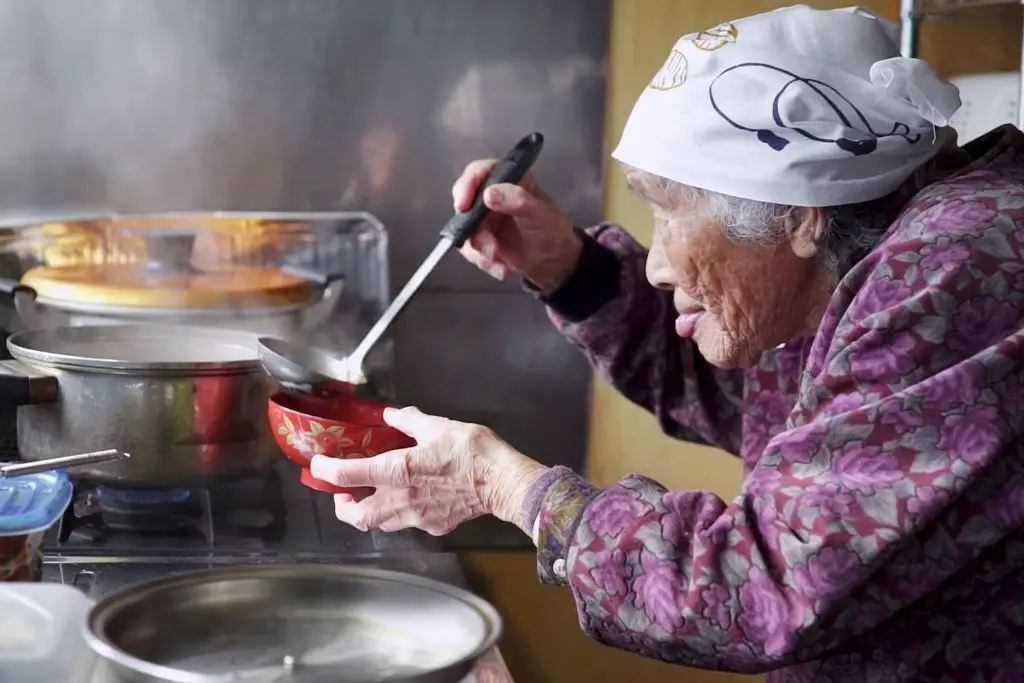
People who follow the government’s diet guidelines tend to own better health.
The guideline advises against intaking more than 10g salt a day. Low salt consumption will help avoid cerebrovascular disease and stomach cancer. Japanese used to eat 14.5 g of salt per day in 1973 when mortality was mainly due to cerebrovascular disease and stomach cancer. In 2017, the Japanese only consume around 9.5 g/day and the mortality from the mentioned disease went down tremendously.
Another advice from the guideline is to eat less oily or fatty foods. Some people even go to lengths to cut down the red meat consumption which usually has much fat. This’s why the obesity rate in Japan is extremely low (4.8% for males and 3.7% for females). Indeed obesity leads to ischemic heart disease and several types of cancers. Instead, the Japanese prefer vegetables, fruits, fish, high-grain-based or high carbohydrate food. And the ingredients should natural, unprocessed.
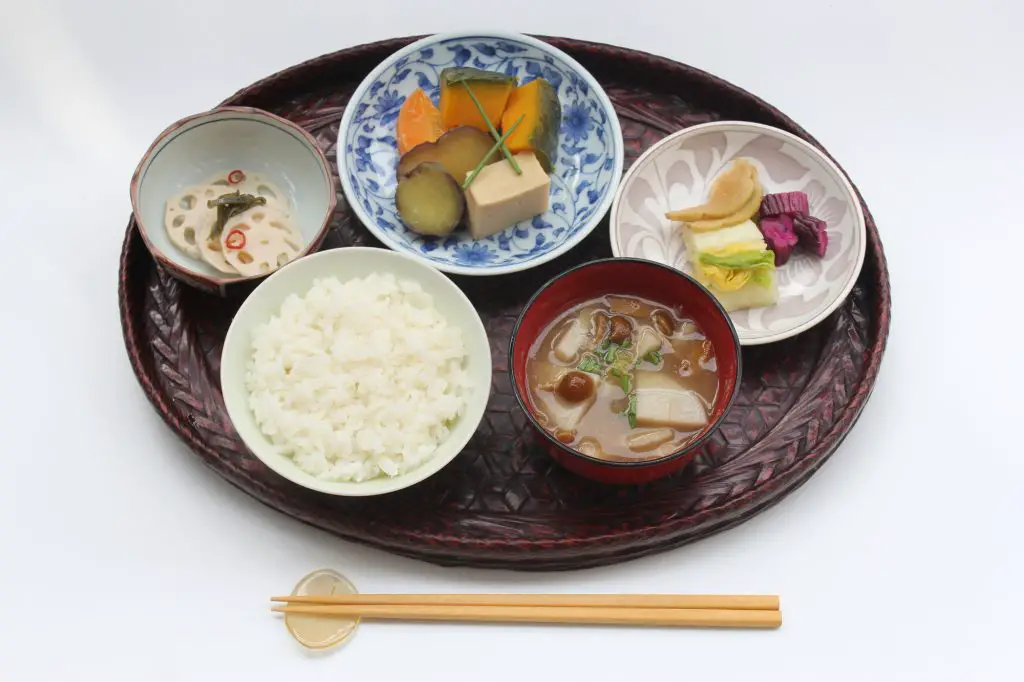
Japanese prefer vegetables, fruits, fish, high-grain-based or high carbohydrate food.
Also according to the Japanese government’s 2005 guidelines, “servings per day” should include various food types and the right amount as follows:
- 5-7 servings of high-grain based foods (rice, pasta, noodles, bread)
- 5-6 servings of vegetables
- 3-5 servings of meat and fish
- 2 servings of fruit
- 2 servings of milk and dairy products
- A moderate amount of snacks, sweets, and alcohol
4.3 Walk and exercise
A sedentary lifestyle causes poor health and proneness to sickness. In contrast, being active will contribute to well-being and longer life. Even though the Japanese live longer, we don’t necessarily work out more. The truth is Japanese tend to involve movement in everyday lives. Approximately 98% of children walk or ride bicycles to schools in Japan. Japanese adults enjoy the rajio taiso (gymnastics radio) to warm up in the morning at home or at work if their companies organize a morning exercise routine. Besides, during their commute, they either walk or cycle to work or to the train station. Japanese seniors, no matter how old, maintain the habit of exercising.
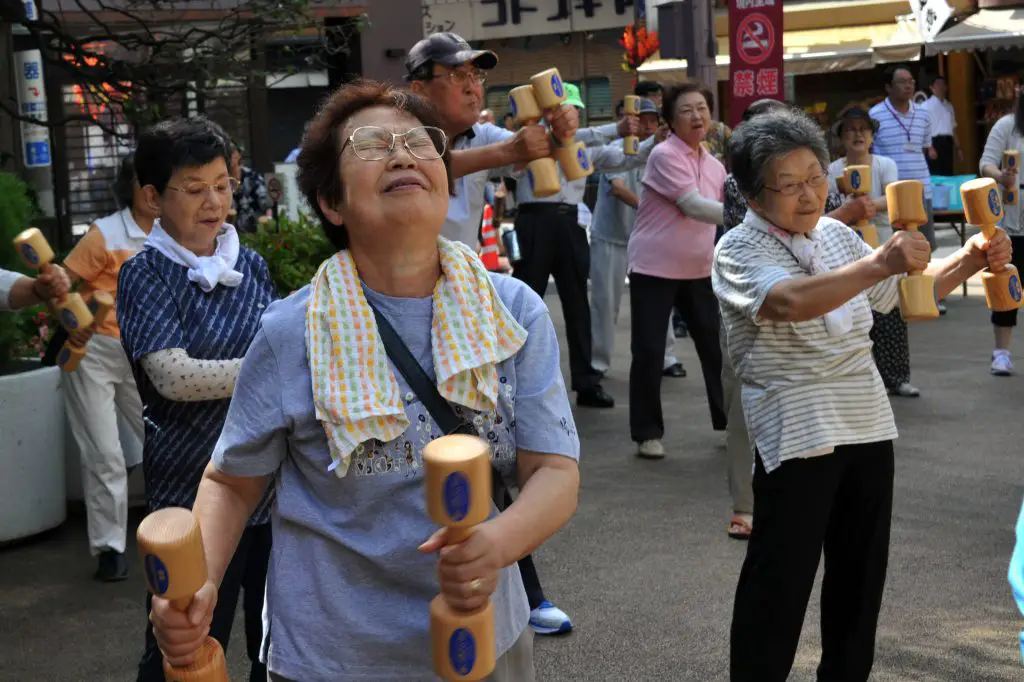
Japanese seniors, no matter how old, maintain the habit of exercising.
Even when the Japanese sit down for meals or meditation, the position, called ‘seiza’, should be on point. Seize requires people to sit upright on the floor with a kneeling posture that involves tucking their feet underneath your bottom. Seize helps rest the shins, improves the blood circulation in the body, and practice flexibility.
4.4 Osen Bath
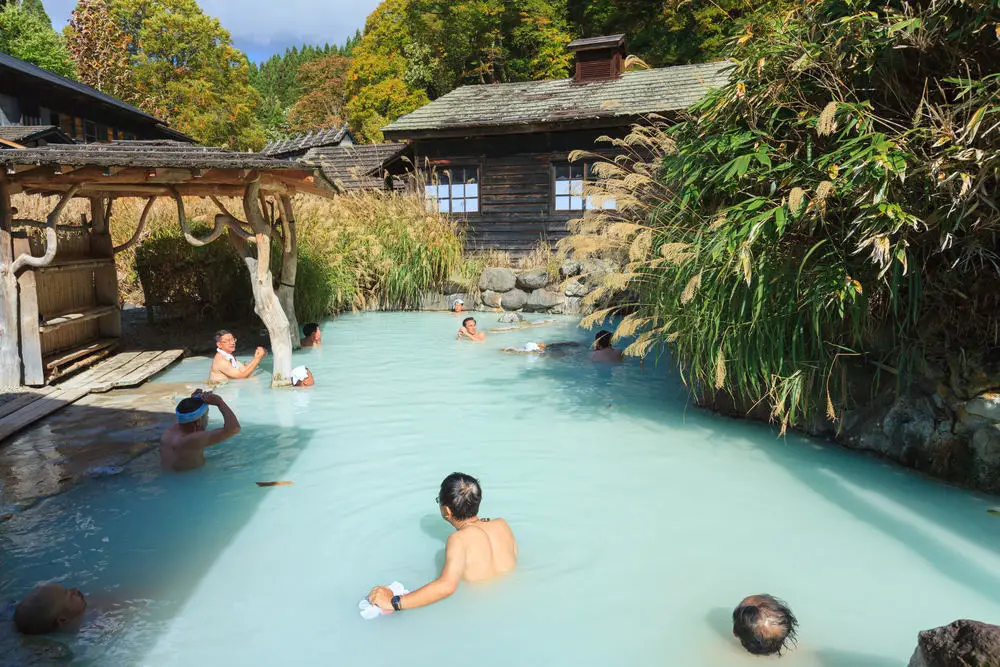
Osen has the effect to calm nerves and put the bather in a relaxed, meditative state.
Japan is blessed with a lot of natural springs and the Japanese adore soaking their bodies in such hot water public bath, called Osen. The natural springs provide minerals for the skin, energize the metabolism and help the body circulating better. Osen has been around for thousands of years. It is now a socially acceptable place to be naked and relieve any pressure from contemporary Japanese twelve-hour work ethic. In this way, Osen has the effect to calm nerves and put the bather in a relaxed, meditative state.
4.5 Health education and hygiene-conscious culture
Education seems irrelevant to life expectancy in short term but it turns down quite effective for the long term. According to the medical journal The Lancet4, the high life expectancy in Japan partly owes to the government’s public health campaigns ever since 1950s and 1960s. The population learns to reduce salt or red meat intake and use medication to reduce blood pressure through these campaigns. People are more engaged in regular check-ups, typically a dozen times per year, four times as much as in the US. They are also open to vaccinations, immunizations and take the health advice from the authority seriously.
We also need to credit hygiene-conscious culture in the country. Japanese are already well-known for our cleanliness. Even the most common practices such as handwashing Japanese conduct properly. And in schools, Japanese students usually undertake cleaning classrooms or the whole campus chores. While in western countries, this practice seems to be child abuse, in Japan, it’s a common cultural thing. It can eventually help the child becoming a responsible citizen in the future. Besides, the cleanliness in Japan is thanks to safe water sufficiency and great sewage systems.
4.6 Ikigai and attitude to life
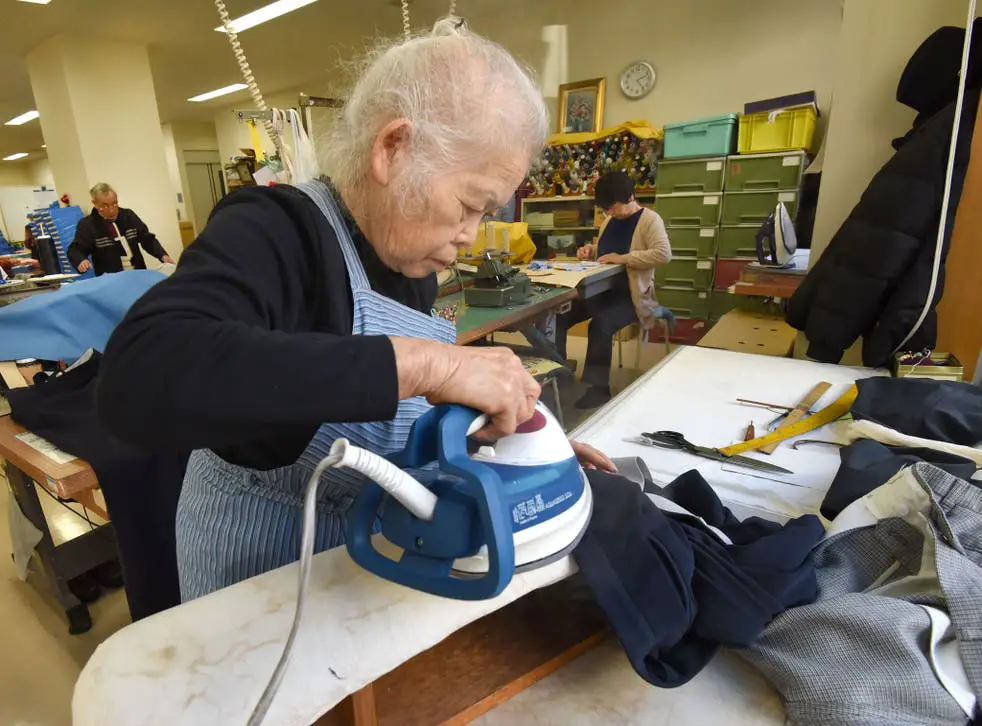
Many seniors in Japan choose to continue working after their retirement to be active well into later life.
You may have heard of the famous concept ‘ikigai’ that originated in Japan. Ikigai basically means ‘the reason to live’ and it recommends people find purpose as well as joy in everyday life. Many seniors in Japan choose to continue working after their retirement, not because of financial burden but they simply want to be active well into later life. Others give back to society by joining small works in the community. They believe that helping others is essential for life fulfillment. Likewise, ikigai philosophy suggests that anything ranging from eating well or being with loving friends and family can bring happiness.
4.7 Economic prosperity and World-class health care
Since the end of World War II, Japan’s economy grows rapidly at the speed of light. It soon became the world’s second-largest (behind the US) between 1968 and 2010, until China’s economy exceeded. In line with the economical development, Japanese Government managed to boost the national healthcare system. They applied universal health insurance including vaccination programs and medical treatments for all populations from 1961. There are regular health screenings in schools and workplaces.
The prosperous economy actively led to medical technology advancements, higher living standards, and expectations. At the same time, the poverty vs wealth gap is quite smaller in Japan than in most other developed countries. The lower the inequality in wealth, the higher life expectancy. Since most population afford good diets and lifestyles. Consequently, disease and deaths decrease tremendously.
FAQs
Who is the oldest person in Japan?
Born in January 1903, Tanaka Kane turned 188 in 2021 and is among the three people ever to reach such age. The Guinness Book of Records has recognized her as the world’s oldest living person at the moment. It is amazing that this lady has defeated cancer twice and lived through two global pandemics.
Where in Japan, the population has the highest level of life expectancy?
Okinawa. It is also called the ‘Land of Immortals’ since it is also home to the world’s highest percentage of centenarians. National Geographic explorer Dan Buettner includes this city in his list of “blue zone,” where he believes people live the longest, happiest lives.
How many elderly are in Japan?
There are 36.17 million people (nearly the population of Poland) aged 65 and higher in Japan, which is equivalent to 28.7 % of the population. In other words, one out of every four Japanese is elderly, making Japan rank first in countries with the oldest population.
How many seniors in Japan continue working after retirement?
Most Japanese companies regulate a uniform retirement age of 60. But 50% of seniors in Japan, who are 70 years old or over, decide to work or volunteer in social activities.



